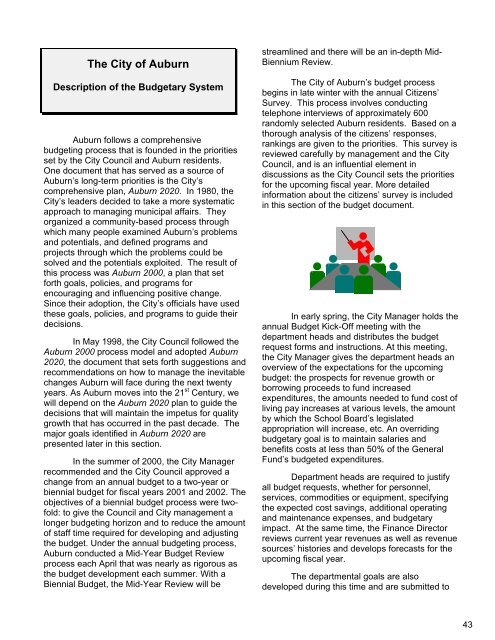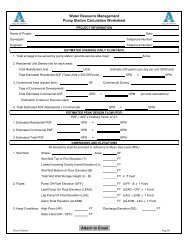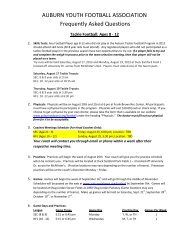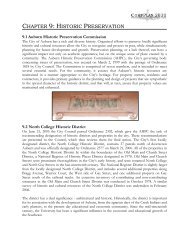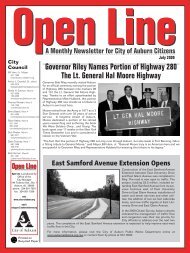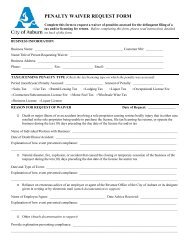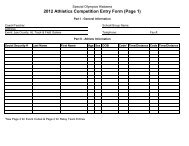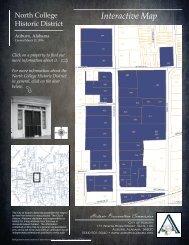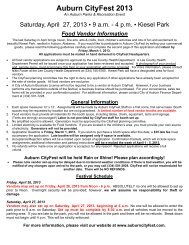Complete Document - City of Auburn
Complete Document - City of Auburn
Complete Document - City of Auburn
You also want an ePaper? Increase the reach of your titles
YUMPU automatically turns print PDFs into web optimized ePapers that Google loves.
The <strong>City</strong> <strong>of</strong> <strong>Auburn</strong>Description <strong>of</strong> the Budgetary System<strong>Auburn</strong> follows a comprehensivebudgeting process that is founded in the prioritiesset by the <strong>City</strong> Council and <strong>Auburn</strong> residents.One document that has served as a source <strong>of</strong><strong>Auburn</strong>’s long-term priorities is the <strong>City</strong>’scomprehensive plan, <strong>Auburn</strong> 2020. In 1980, the<strong>City</strong>’s leaders decided to take a more systematicapproach to managing municipal affairs. Theyorganized a community-based process throughwhich many people examined <strong>Auburn</strong>’s problemsand potentials, and defined programs andprojects through which the problems could besolved and the potentials exploited. The result <strong>of</strong>this process was <strong>Auburn</strong> 2000, a plan that setforth goals, policies, and programs forencouraging and influencing positive change.Since their adoption, the <strong>City</strong>’s <strong>of</strong>ficials have usedthese goals, policies, and programs to guide theirdecisions.In May 1998, the <strong>City</strong> Council followed the<strong>Auburn</strong> 2000 process model and adopted <strong>Auburn</strong>2020, the document that sets forth suggestions andrecommendations on how to manage the inevitablechanges <strong>Auburn</strong> will face during the next twentyyears. As <strong>Auburn</strong> moves into the 21 st Century, wewill depend on the <strong>Auburn</strong> 2020 plan to guide thedecisions that will maintain the impetus for qualitygrowth that has occurred in the past decade. Themajor goals identified in <strong>Auburn</strong> 2020 arepresented later in this section.In the summer <strong>of</strong> 2000, the <strong>City</strong> Managerrecommended and the <strong>City</strong> Council approved achange from an annual budget to a two-year orbiennial budget for fiscal years 2001 and 2002. Theobjectives <strong>of</strong> a biennial budget process were tw<strong>of</strong>old:to give the Council and <strong>City</strong> management alonger budgeting horizon and to reduce the amount<strong>of</strong> staff time required for developing and adjustingthe budget. Under the annual budgeting process,<strong>Auburn</strong> conducted a Mid-Year Budget Reviewprocess each April that was nearly as rigorous asthe budget development each summer. With aBiennial Budget, the Mid-Year Review will bestreamlined and there will be an in-depth Mid-Biennium Review.The <strong>City</strong> <strong>of</strong> <strong>Auburn</strong>’s budget processbegins in late winter with the annual Citizens’Survey. This process involves conductingtelephone interviews <strong>of</strong> approximately 600randomly selected <strong>Auburn</strong> residents. Based on athorough analysis <strong>of</strong> the citizens’ responses,rankings are given to the priorities. This survey isreviewed carefully by management and the <strong>City</strong>Council, and is an influential element indiscussions as the <strong>City</strong> Council sets the prioritiesfor the upcoming fiscal year. More detailedinformation about the citizens’ survey is includedin this section <strong>of</strong> the budget document.In early spring, the <strong>City</strong> Manager holds theannual Budget Kick-Off meeting with thedepartment heads and distributes the budgetrequest forms and instructions. At this meeting,the <strong>City</strong> Manager gives the department heads anoverview <strong>of</strong> the expectations for the upcomingbudget: the prospects for revenue growth orborrowing proceeds to fund increasedexpenditures, the amounts needed to fund cost <strong>of</strong>living pay increases at various levels, the amountby which the School Board’s legislatedappropriation will increase, etc. An overridingbudgetary goal is to maintain salaries andbenefits costs at less than 50% <strong>of</strong> the GeneralFund’s budgeted expenditures.Department heads are required to justifyall budget requests, whether for personnel,services, commodities or equipment, specifyingthe expected cost savings, additional operatingand maintenance expenses, and budgetaryimpact. At the same time, the Finance Directorreviews current year revenues as well as revenuesources’ histories and develops forecasts for theupcoming fiscal year.The departmental goals are alsodeveloped during this time and are submitted to43


